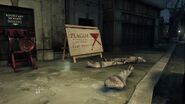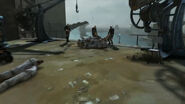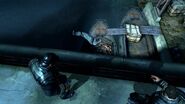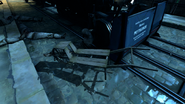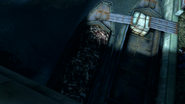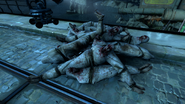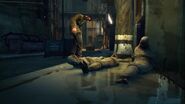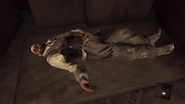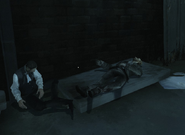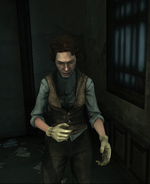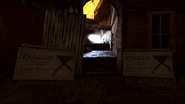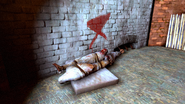No edit summary |
Tag: Visual edit |
||
| (45 intermediate revisions by 20 users not shown) | |||
| Line 1: | Line 1: | ||
{{Spoilers}} |
{{Spoilers}} |
||
| − | [[File: |
+ | [[File:Plague x.png|225px|right]] |
| − | {{Quote|A crawling foulness will overcome you because you did not shut the gates of your heart to iniquity.|A prophetic warning of the rat plague |
+ | {{Quote|A crawling foulness will overcome you because you did not shut the gates of your heart to iniquity.|A prophetic warning of the rat plague}} |
| ⚫ | The '''rat plague''' (called "''The Doom of [[Pandyssian Continent|Pandyssia]]''" by the [[The Heart|Heart]]<ref>[[The Heart/Quotes#Multiple Environments|''"The doom of Pandyssia has come to the city."'']]</ref>) is a rodent-borne contagious disease, responsible for the decimation of the population of [[Dunwall]] during the events of ''[[Dishonored]]''. According to studies conducted by [[Luigi Galvani|Doctor Galvani]], the plague has an unusual migration pattern:<ref>[[Galvani's Speculation]]</ref> the oldest strains of the disease exist in the city's slums and other impoverished districts, rather than the docks, the most likely location for invasive foreign pests to have entered the city.<ref>[[The Rat Plague (book)]]</ref> |
||
| − | |||
| ⚫ | The '''rat plague''' |
||
[[Corvo Attano]] eventually discovers that the plague was introduced to Dunwall by [[The Royal Spymaster|Royal Spymaster]] [[Hiram Burrows]] as a means of putting an end to poverty in the city, with the results proving catastrophic.<ref>[[The Lord Regent's Confession]]</ref> |
[[Corvo Attano]] eventually discovers that the plague was introduced to Dunwall by [[The Royal Spymaster|Royal Spymaster]] [[Hiram Burrows]] as a means of putting an end to poverty in the city, with the results proving catastrophic.<ref>[[The Lord Regent's Confession]]</ref> |
||
==Symptoms and Treatment== |
==Symptoms and Treatment== |
||
| − | [[File: |
+ | [[File:Plague victim2.png|thumb|200px|Weepers chase Corvo.]] |
| + | {{Quote|Hear her terrible moans! The disease is both painful and disfiguring.|The Heart<ref>[[The Heart/Quotes#Female Weeper|''"Hear her terrible moans! The disease is both painful and disfiguring."'']]</ref>}} |
||
Symptoms of the plague include discolored skin (particularly on the face and chest), weight loss, and thinning of the hair. As the disease progresses, the lungs and brain become more damaged, leaving its sufferers with a chronic cough and a significant decrease in cognitive ability. |
Symptoms of the plague include discolored skin (particularly on the face and chest), weight loss, and thinning of the hair. As the disease progresses, the lungs and brain become more damaged, leaving its sufferers with a chronic cough and a significant decrease in cognitive ability. |
||
Late-stage symptoms include subconjunctival hemorrhaging, which causes blood to drip from the eyes, and infestation by parasitic stinging insects. Early efforts to combat the plague are fruitless once these symptoms surface, and prior to the discovery of a cure, the disease is lethal at this stage.<ref>[[Weeper Identification and Handling]]</ref> Plague sufferers in the last stages of the disease are known colloquially as "[[weepers]]". |
Late-stage symptoms include subconjunctival hemorrhaging, which causes blood to drip from the eyes, and infestation by parasitic stinging insects. Early efforts to combat the plague are fruitless once these symptoms surface, and prior to the discovery of a cure, the disease is lethal at this stage.<ref>[[Weeper Identification and Handling]]</ref> Plague sufferers in the last stages of the disease are known colloquially as "[[weepers]]". |
||
| − | Preventative methods, such as [[Sokolov's Elixir]] and [[Piero's Spiritual Remedy]], exist but are expensive and scarce. As such, they are generally not affordable to the majority of citizens in Dunwall. Cheaper and less effective methods for combating the disease have emerged, including bootleg elixir produced by the [[Bottle Street Gang |
+ | Preventative methods, such as [[Sokolov's Elixir]] and [[Piero's Spiritual Remedy]], exist but are expensive and scarce. As such, they are generally not affordable to the majority of citizens in Dunwall. Cheaper and less effective methods for combating the disease have emerged, including bootleg elixir produced by the [[Bottle Street Gang]],<ref>[[Lieutenant Niles' Report]]</ref> homeopathic remedies, and ritualistic ceremonies.<ref>[[Avoiding the Rat Plague]]</ref> Although official sources discourage the use of these methods, given the inaccessibility of elixirs, they are still commonly used. |
| − | Natural resistance to the |
+ | Natural resistance to the plague does exist, as explained by a doctor in the [[Flooded District]] who is caring for a dying patient. He emphasizes, however, that the chances of the body fighting off the disease on its own are "a thousand, probably ''ten ''thousand, to one." [[Mace Brimsley]] is one such immune individual.<ref>[[Mace Brimsley's Journal]]</ref> There are also those who carry the plague but will not themselves turn into a weeper.<ref>[[The Heart/Quotes#Courtesan|''"She is a plague carrier, infectious, but not ill. And she knows it."'']]</ref> |
==Prevention Efforts== |
==Prevention Efforts== |
||
| − | [[File: |
+ | [[File:sr corpses2.png|thumb|200px|Corpses in front of a barrier warning about the plague.]] |
| + | {{Quote|There is always a cure! The question is - what are you willing to sacrifice to have it?|Anton Sokolov<ref>[[Our Natural Philosophers, By Kenneth Obenshaw]]</ref>}} |
||
| − | The rat plague has killed half of Dunwall's population since its initial spread. [[ |
+ | The [[Rats|rat]] plague has killed half of Dunwall's population since its initial spread. [[Rulers of the Empire of the Isles|Empress]] [[Jessamine Kaldwin]] sent Corvo to solicit the other nations of the [[Empire of the Isles|Empire]] for aid in stemming the plague, but the effort was in vain, and Dunwall was subsequently blockaded. |
| + | [[File:Rat plague signs1.png|left|150px]] |
||
| ⚫ | While the Empress was unwilling to use draconian measures of containment to prevent the plague's spread, others in her government were not; following her assassination, Lord Regent Burrows institutes martial law and commissions [[Anton Sokolov]] to invent new methods of containment. [[Wall of Light| |
||
| + | [[File:Rat plague signs2.png|left|150px]] |
||
| + | [[File:Rat plague signs3.png|left|150px]] |
||
| ⚫ | While the Empress was unwilling to use draconian measures of containment to prevent the plague's spread, others in her government were not; following her assassination, Lord Regent Burrows institutes martial law and commissions [[Anton Sokolov]] to invent new methods of containment. [[Wall of Light|walls of light]] quarantine infected areas, a dusk-to-dawn curfew has been instituted (both to reduce human contact with rats and to decrease the chance of infected individuals breaking quarantine), and both [[City Watch|civil]] and [[Abbey of the Everyman|religious]] officials have been given wide-reaching power to deal with disruptive or uncooperative persons. |
||
| ⚫ | Red crosses mark buildings where the plague has struck, and linen-wrapped bodies that await disposal litter [[Streets of Dunwall|Dunwall's streets]] and residences. Guards are instructed to place these corpses on barges and then trains bound for the Flooded District by official [[Dead Counters]];<ref>[[Dead Counter Responsibilities]]</ref> however, some guards have taken to dumping them into the city's waterways to avoid prolonged exposure to the disease, if the bodies are not first consumed by rats. |
||
| ⚫ | |||
| ⚫ | Red crosses mark buildings where the plague has struck, and linen-wrapped bodies that await disposal litter Dunwall's streets and residences. |
||
| − | |||
| ⚫ | Individuals suspected of contracting the plague have their property and assets immediately seized by [[Arnold Timsh| |
||
[[File:Pierosokolovcure.jpg|thumb|200px|Piero and Sokolov dispensing the plague cure.]] |
[[File:Pierosokolovcure.jpg|thumb|200px|Piero and Sokolov dispensing the plague cure.]] |
||
| ⚫ | Individuals suspected of contracting the plague have their property and assets immediately seized by the [[Arnold Timsh|City Barrister]], which are transferred to the state if there are no surviving kin to inherit.<ref>[[Eminent Domain (book)]]</ref><ref>[[The City Barrister]]</ref> Corruption and bribery within the [[Legal District]] has led to false claims of infection on otherwise healthy persons so that their property may be seized for political and financial gain.<ref>[[Timsh's Daily Business]]</ref> |
||
| ⚫ | During the infestation, scientists such as |
||
| + | |||
| ⚫ | During the infestation, scientists such as Doctor Galvani and Anton Sokolov conduct research to find a cure for the plague, occasionally in secret due to a ban on certain scientific practices.<ref>[[Galvani Academy Notice]]</ref> In the low [[chaos]] ending of ''Dishonored'', provided that both [[Piero Joplin]] and Anton Sokolov survive, they combine their efforts and find a cure for the plague that heals even late-stage victims. They can at one point be seen curing weepers in their shared laboratory. |
||
==Trivia== |
==Trivia== |
||
| − | *The rat plague |
+ | *The rat plague is loosely based on the real-world bubonic/septicemic plague.<ref>[https://www.reddit.com/r/IAmA/comments/x58ul/weare_harvey_and_raphael_cocreative_directors_of/c5jdhbd/?context=1 Developer Commentary – Setting]</ref> It too was an all-consuming disease that was thought to be carried by rodents in the Middle Ages (in reality, it was carried by the fleas living in the rats' fur, as well as through direct contact with those already infected, but this was not discovered until centuries later). The environment of Dunwall also reflects this parallel, as bodies littered the streets during the bubonic plague, with the same happening in Dunwall. Also, houses infected by the bubonic plague were marked with a cross, which corresponds with those marked on select houses in Dunwall. |
**Unlike the bubonic plague, however, the drastic measures put in place to stop the spread such as sealing houses and whole districts did not prove effective in Dunwall. This is most likely due to the plague's deliberate introduction and the pervasiveness of the rats. |
**Unlike the bubonic plague, however, the drastic measures put in place to stop the spread such as sealing houses and whole districts did not prove effective in Dunwall. This is most likely due to the plague's deliberate introduction and the pervasiveness of the rats. |
||
| − | *An [[Serkonos| |
+ | *An old [[Serkonos|Serkonan]] [[Death in the Month of Songs|poem]] tells the tale of death caused by a "a disease from the East", suggesting that there was an awareness of the plague long before it reached Dunwall. |
| + | *A [[Aristocrats|guest]] at the [[Lady Boyle's Last Party|Boyle Party]] claims that the "rats came a half year before the Empress died". |
||
| + | *When examining the [[courtesans]] in the [[The Golden Cat|Golden Cat]], the Heart will comment: "The streetwalkers. Only the rats spread the plague faster." hinting that disease also spreads through sexual contact.<ref>[[The Heart/Quotes#Courtesan|''"The streetwalkers. Only the rats spread the plague faster."'']]</ref> |
||
| + | *The plague caused a number of riots, often shutting down streets. |
||
| + | *A number of individuals believed that the plague was spread by infectious winds, and all one had to do was hide from those until they moved on.<ref>[[Old Diary]]</ref> |
||
==Gallery== |
==Gallery== |
||
| + | <div class="scrollbox"> |
||
| − | <div style="height:575px;width:675px;border:1px solid #683B35;font:16px/26px;overflow:auto;"> |
||
| − | <gallery captionalign="center" position="center |
+ | <gallery captionalign="center" position="center"> |
| + | Corpses.jpg|Corpse renders. |
||
| ⚫ | |||
plague-mask.png|A guard wearing a mask to avoid catching the plague. |
plague-mask.png|A guard wearing a mask to avoid catching the plague. |
||
plaguecorpsesea.jpg|Plague corpses are unceremoniously dumped into the waterways of Dunwall. |
plaguecorpsesea.jpg|Plague corpses are unceremoniously dumped into the waterways of Dunwall. |
||
| − | + | Theheartisahomeforghosts dead counter01.png|The City Watch disposes of plague victims. |
|
Theheartisahomeforghosts dead counter02.jpg|Guards throw the corpses of the plague-dead into a boat. |
Theheartisahomeforghosts dead counter02.jpg|Guards throw the corpses of the plague-dead into a boat. |
||
Dcount04.png|Corpses of the plague dead. |
Dcount04.png|Corpses of the plague dead. |
||
| Line 58: | Line 67: | ||
Slaughterhouse row alley.png|Signs warning about the plague in Slaughterhouse Row. |
Slaughterhouse row alley.png|Signs warning about the plague in Slaughterhouse Row. |
||
sr corpses.png|Dead plague victims with a red x. |
sr corpses.png|Dead plague victims with a red x. |
||
| − | sr corpses2.png|Corpses in front of a barrier warning about the plague. |
||
plague sheets01.png|Sheets for the plague dead. |
plague sheets01.png|Sheets for the plague dead. |
||
plague victim01.png|Rotting plague dead. |
plague victim01.png|Rotting plague dead. |
||
| Line 66: | Line 74: | ||
==References== |
==References== |
||
{{Reflist}} |
{{Reflist}} |
||
| + | |||
| + | {{Navbox World}} |
||
| + | |||
| + | [[es:Plaga de ratas]] |
||
| + | [[ru:Крысиная чума]] |
||
| + | [[pl:Szczurza zaraza]] |
||
| + | [[fr:Peste]] |
||
| + | [[it:Peste di Ratto]] |
||
| + | [[zh:鼠疫]] |
||
[[Category:Lore]] |
[[Category:Lore]] |
||
Revision as of 19:45, 4 July 2020
- "A crawling foulness will overcome you because you did not shut the gates of your heart to iniquity."
- —A prophetic warning of the rat plague
The rat plague (called "The Doom of Pandyssia" by the Heart[1]) is a rodent-borne contagious disease, responsible for the decimation of the population of Dunwall during the events of Dishonored. According to studies conducted by Doctor Galvani, the plague has an unusual migration pattern:[2] the oldest strains of the disease exist in the city's slums and other impoverished districts, rather than the docks, the most likely location for invasive foreign pests to have entered the city.[3]
Corvo Attano eventually discovers that the plague was introduced to Dunwall by Royal Spymaster Hiram Burrows as a means of putting an end to poverty in the city, with the results proving catastrophic.[4]
Symptoms and Treatment
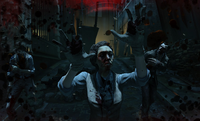
Weepers chase Corvo.
- "Hear her terrible moans! The disease is both painful and disfiguring."
- —The Heart[5]
Symptoms of the plague include discolored skin (particularly on the face and chest), weight loss, and thinning of the hair. As the disease progresses, the lungs and brain become more damaged, leaving its sufferers with a chronic cough and a significant decrease in cognitive ability.
Late-stage symptoms include subconjunctival hemorrhaging, which causes blood to drip from the eyes, and infestation by parasitic stinging insects. Early efforts to combat the plague are fruitless once these symptoms surface, and prior to the discovery of a cure, the disease is lethal at this stage.[6] Plague sufferers in the last stages of the disease are known colloquially as "weepers".
Preventative methods, such as Sokolov's Elixir and Piero's Spiritual Remedy, exist but are expensive and scarce. As such, they are generally not affordable to the majority of citizens in Dunwall. Cheaper and less effective methods for combating the disease have emerged, including bootleg elixir produced by the Bottle Street Gang,[7] homeopathic remedies, and ritualistic ceremonies.[8] Although official sources discourage the use of these methods, given the inaccessibility of elixirs, they are still commonly used.
Natural resistance to the plague does exist, as explained by a doctor in the Flooded District who is caring for a dying patient. He emphasizes, however, that the chances of the body fighting off the disease on its own are "a thousand, probably ten thousand, to one." Mace Brimsley is one such immune individual.[9] There are also those who carry the plague but will not themselves turn into a weeper.[10]
Prevention Efforts
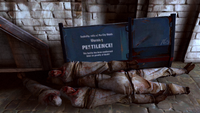
Corpses in front of a barrier warning about the plague.
- "There is always a cure! The question is - what are you willing to sacrifice to have it?"
- —Anton Sokolov[11]
The rat plague has killed half of Dunwall's population since its initial spread. Empress Jessamine Kaldwin sent Corvo to solicit the other nations of the Empire for aid in stemming the plague, but the effort was in vain, and Dunwall was subsequently blockaded.
While the Empress was unwilling to use draconian measures of containment to prevent the plague's spread, others in her government were not; following her assassination, Lord Regent Burrows institutes martial law and commissions Anton Sokolov to invent new methods of containment. walls of light quarantine infected areas, a dusk-to-dawn curfew has been instituted (both to reduce human contact with rats and to decrease the chance of infected individuals breaking quarantine), and both civil and religious officials have been given wide-reaching power to deal with disruptive or uncooperative persons.
Red crosses mark buildings where the plague has struck, and linen-wrapped bodies that await disposal litter Dunwall's streets and residences. Guards are instructed to place these corpses on barges and then trains bound for the Flooded District by official Dead Counters;[12] however, some guards have taken to dumping them into the city's waterways to avoid prolonged exposure to the disease, if the bodies are not first consumed by rats.

Piero and Sokolov dispensing the plague cure.
Individuals suspected of contracting the plague have their property and assets immediately seized by the City Barrister, which are transferred to the state if there are no surviving kin to inherit.[13][14] Corruption and bribery within the Legal District has led to false claims of infection on otherwise healthy persons so that their property may be seized for political and financial gain.[15]
During the infestation, scientists such as Doctor Galvani and Anton Sokolov conduct research to find a cure for the plague, occasionally in secret due to a ban on certain scientific practices.[16] In the low chaos ending of Dishonored, provided that both Piero Joplin and Anton Sokolov survive, they combine their efforts and find a cure for the plague that heals even late-stage victims. They can at one point be seen curing weepers in their shared laboratory.
Trivia
- The rat plague is loosely based on the real-world bubonic/septicemic plague.[17] It too was an all-consuming disease that was thought to be carried by rodents in the Middle Ages (in reality, it was carried by the fleas living in the rats' fur, as well as through direct contact with those already infected, but this was not discovered until centuries later). The environment of Dunwall also reflects this parallel, as bodies littered the streets during the bubonic plague, with the same happening in Dunwall. Also, houses infected by the bubonic plague were marked with a cross, which corresponds with those marked on select houses in Dunwall.
- Unlike the bubonic plague, however, the drastic measures put in place to stop the spread such as sealing houses and whole districts did not prove effective in Dunwall. This is most likely due to the plague's deliberate introduction and the pervasiveness of the rats.
- An old Serkonan poem tells the tale of death caused by a "a disease from the East", suggesting that there was an awareness of the plague long before it reached Dunwall.
- A guest at the Boyle Party claims that the "rats came a half year before the Empress died".
- When examining the courtesans in the Golden Cat, the Heart will comment: "The streetwalkers. Only the rats spread the plague faster." hinting that disease also spreads through sexual contact.[18]
- The plague caused a number of riots, often shutting down streets.
- A number of individuals believed that the plague was spread by infectious winds, and all one had to do was hide from those until they moved on.[19]
Gallery
References
- ↑ "The doom of Pandyssia has come to the city."
- ↑ Galvani's Speculation
- ↑ The Rat Plague (book)
- ↑ The Lord Regent's Confession
- ↑ "Hear her terrible moans! The disease is both painful and disfiguring."
- ↑ Weeper Identification and Handling
- ↑ Lieutenant Niles' Report
- ↑ Avoiding the Rat Plague
- ↑ Mace Brimsley's Journal
- ↑ "She is a plague carrier, infectious, but not ill. And she knows it."
- ↑ Our Natural Philosophers, By Kenneth Obenshaw
- ↑ Dead Counter Responsibilities
- ↑ Eminent Domain (book)
- ↑ The City Barrister
- ↑ Timsh's Daily Business
- ↑ Galvani Academy Notice
- ↑ Developer Commentary – Setting
- ↑ "The streetwalkers. Only the rats spread the plague faster."
- ↑ Old Diary
World of the Dishonored franchise | |
|---|---|
| Geography |
The Isles (Gristol • Morley • Serkonos • Tyvia) • Dunwall • Karnaca • Pandyssian Continent |
| History |
The Loyalist Conspiracy • Rat Plague • Siege of White Cliff • Timeline • The Great Burning |
| Beliefs | |
| Authority |
City Watch • Empire of the Isles • Grand Guard • Warfare Overseers |
| Science | |
| Documents | |







